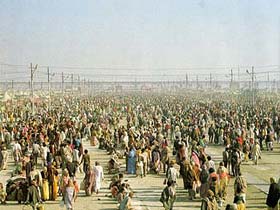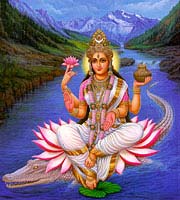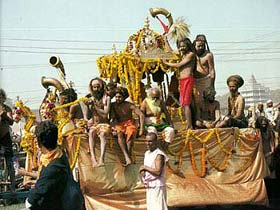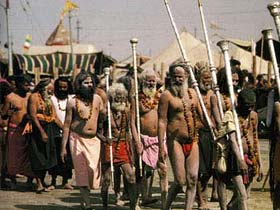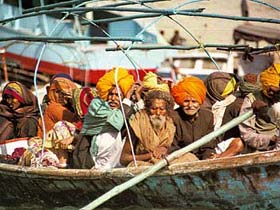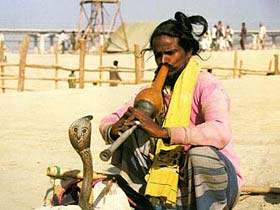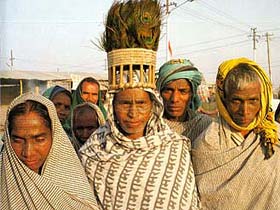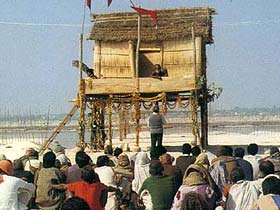 |
| http://newsiswealth.blogspot.in/ |
Interestingly, practically none of the
practitioners of Vastu Shastra has an academic background. So there is a
lot of genuine practice as well as hearsay going around. In this brief
introduction, the intention is to give a broad overall picture of the
Vastu Shastra with some examples.
Vastu Shastras are canons dealing with the
subject of vastu which means the environment. Put differently, one may
regard them as codification of good practices of design of buildings and
cities, which will provide settings for the conduct of human life in
harmony with physical as well as metaphysical forces. These Vastu
Shastra canons provide guidelines for design of buildings and planning
of cities such that they will bring health, wealth and peace to the
inhabitants.
 Mythological
beliefs are certainty at the root of the origins of these canonical
texts and their discourse. The first of these relates to Vastupurusha,
which appears to be the first step in ordering a part of the vast cosmic
space, the brahmanda, for human habitation. According to myth, long ago
there existed an unnamed, unknown and formless being which blocked the
sky and the earth. The Gods forced it down on earth and pressed it face
down. To ensure that it did not escape again, Lord Brahma, the supreme
creator, along with other gods weighted it down and called it
vastupurusha.
Mythological
beliefs are certainty at the root of the origins of these canonical
texts and their discourse. The first of these relates to Vastupurusha,
which appears to be the first step in ordering a part of the vast cosmic
space, the brahmanda, for human habitation. According to myth, long ago
there existed an unnamed, unknown and formless being which blocked the
sky and the earth. The Gods forced it down on earth and pressed it face
down. To ensure that it did not escape again, Lord Brahma, the supreme
creator, along with other gods weighted it down and called it
vastupurusha.
Lord Brahma, of course, occupied the central
portion and in a hierarchic distribution along concentric rings
assigned different quarters to different major and minor gods. Thus
emerged a geometric configuration, which is called mandala. From one
basic square, the canons have listed up to 1024 divisions of a square
and given each one a name. The most popular among those have 64 and 81
divisions known as Manduka Mandala and Param Sayika Mandala,
respectively, which are widely used for temple and dwelling plans.
 |
| http://newsiswealth.blogspot.in/ |
The mandala is also given an orientation
with Surya, the sun-god, occupying the central point of periphery to
east; Varuna, the Lord of winds, to the west; Kubera, the Lord of
Wealth, to the north; and Yama, the Lord of Death, to the south. The
rest of the squares are occupied by the other minor gods. With the
positions thus assigned and the beneficial or otherwise attributes of
gods established through other myths, it is possible to assign the
activities of living, working and support facilities over the mandala
and therefore the layout of a city or a building.
The mandala is, of course, the most popular
aspect of the vastushastras as it is constantly referred to for the
location of the various activities in a building. The proper texts
themselves, however, deal with a wide range of topics relating to
built-environment. These include site selection, soil testing, building
materials and techniques, design of temples separately by number of
floors, palaces, dwellings, gates, image of the deity, their vehicles
and seats even including the making of image of a linga for Shiva
temples. All these are treated in different chapters of the canonical
texts.
As an example, one may mention the matter of
site selection, which is dealt with in both scientific and religious
terms. The method of digging a pit and refilling it with excavated earth
is given scientific treatment. If a lot of earth is left out, then the
soil is compact with good load-bearing capacity.
A similar test checks the seepage of water
in the soil. It if is quick, the soil is obviously not good. The
religious prescription suggest that if the soil is white with ghee-like
smell, it is good for Brahmins, if red with blood-like smell it is good
for Kashtriyas, yellow with smell like sesamum oil, it is good for
Vaishyas and black with the smell of rotten fish, it is good for
Shudras. While the first two suggestions would still find the approval
of a modern engineer, the third more likely betrays the caste-ridden
nature of some of the Shastra's recommendations.
The Shastras also deal at length with town
planning and form of towns suitable for different purposes such as
administrative towns, hill towns, coastal towns or religious towns built
at a sacred place. Among the most famous examples of a town planned
according to these standards is the example of Old Jaipur which is based
on a Prastar type town described in several texts. Built in 1727 AD,
the final form and structure of the town shows a skillful manipulation,
according to the Shastra's prescriptions, of the square mandala right
from the whole to the smallest of the plots, the location of activities,
and distribution of the caste groups.
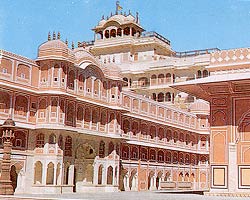 |
| http://newsiswealth.blogspot.in/ |
Jaipur City Palace
Based on the studies carried out by scholars
it is suggested that these texts were written down largely between the
7th century AD to 13th century AD following the Gupta period. They are
found in all the major languages of medieval India. Of course, the
earliest references are also found in the Vedas, which deal with
carpentry among other subjects.
Vastusastras can be said to be companion
texts to Shilpasastras and Chitrasastras dealing with sculpture, icons
and painting respectively. Strangely, among all these texts, those
devoted exclusively to one of the areas. i.e. vastu, chitra or shilpa
are rare. This is because in the Indian artistic traditions, each was an
important and integral part of the creative endeavor largely because
all of these, including performing arts such as the dance and music,
were based at the temple.
Among the vasthusastra texts are Mansar,
Maymata, Vishwakarma and Samrangana Sutradhara which is credited to Raja
Bhoja. The others are believed to have been authored by ancient saints
and sages. These include Lord Vishwakarma who is architect to the gods
in the Nagara or northern traditions, and Maya who is architect to the
gods in the Dravida or Southern tradition. In the northern tradition
Maya is regarded as architect to the danavas or demons. To give some
idea about the size of the text, Masar comprises 5400 verses organized
in a total of 70 chapters.

However, the nature, content and format of
the texts as discussed above is in total contrast to the books that have
recently been published and gone through, in some cases, half a dozen
reprints in a span of one year. They share very little in common. As to
what are the origins of the practitioners' texts recently published, I
can only suggest that these would he more ritualistic practices broadly
interpreted by the various puranic texts such as Agni Purana, Matsya
Purana and their Agmic versions in the Dravidian traditions. The
parallel I can draw upon is of Brigusamhita used by the palmists, which
by itself has no serious pretensions to astronomy. The practitioners
themselves are silent and unresponsive when questioned about these
aspects.
One of the more recent texts goes so far as
to suggest the location of two weighing scales in different parts of the
plot in a factory. One was for weighing raw materials which would in
that location weigh less than actual, and the other one of weighing
finished goods which would register more weight than actual. Very neat,
one may say, and very tempting for the factory owner.
 As
to the beneficial aspects of following these suggestions, the available
experience is equally divided. There seems to be an equal number of
success stories as well as failures. Here, I believe, the analogy of the
typical palmist is best. Perhaps there are genuine jyotish shastris as
well as frauds. Is it that human beings want to be able to put blame on
some unknown forces for failures? Or that they would want to appease the
unknown to ensure a success? These are more a matter of faith rather
than belief.
As
to the beneficial aspects of following these suggestions, the available
experience is equally divided. There seems to be an equal number of
success stories as well as failures. Here, I believe, the analogy of the
typical palmist is best. Perhaps there are genuine jyotish shastris as
well as frauds. Is it that human beings want to be able to put blame on
some unknown forces for failures? Or that they would want to appease the
unknown to ensure a success? These are more a matter of faith rather
than belief.
Fortunately, Indians are not alone in this
in recent times. Across Asia there is a resurgence of these beliefs and
practices. Feng-shui, the Chinese version of Vastusastras, is practiced
all over the Far East and South-east Asia. There, too, the situation is
one of either you believe and practice or you don't believe and don't
practice. Does this mean that one cannot explain this on a rational
basis?
These texts (i.e. the genuine ancient and
medieval canons) dealt with the classical manner of arts and
architecture. This meant that irrespective of who was doing what and
where, a certain quality, content and perfection would always be
achieved just by following the texts. To paraphrase Einstein's
observation for a similar work, "it makes good easy and bad difficult".
This means that a temple made on the banks of Ganga would be as perfect
as one made on shipra though patronised and designed by different
persons.
Even those uninitiated can learn and
practice the entire range of connected activities right from the
selection of a site to the execution of all the elemental details. Then
there is some reason to believe that some of the suggestions may indeed
reflect more real concerns such as climatic suitability of locating the
human activities in a building. An entrance front north ensures that it
will always be in cool shade in India, besides allowing the wealth to
flow in as it is the direction of Lord Kubera. The next alternative of
entrance from east certainly brightens up the morning environment with
the first rays of sun to start a great new day on a cheerful note.
 |
| http://newsiswealth.blogspot.in/ |
Then there is a metaphysical aspect to it
all. This one concerns the fears of the unknown on one hand, and
attempts to intellectually grasp the nature of the world on the other
hand. And between these two is the human desire to do things right, in
conformity and in harmony with the unknown world and its forces. This is
where particularly the mandala diagrams become very useful. These, in
abstract terms, manifest or represent the cosmological conception of the
world, albeit the world as conceived or interpreted by the ancient and
the medieval scholars.
It is therefore natural that buildings and
cities which represent a significant alteration of the terrestrial world
be based on the mandala to make them harmonize with the unknown world.
In other words, it, is undertaking a human act in tune with the nature
as well as the unknown in the belief that these will not clash but work
harmoniously to bring peace and prosperity to the builder and the
inhabitants.
Architecture is a human act. It requires
carving out a segment of that omnipotent, universal space of the
brahmanda, the cosmic space, for the use of the human beings. It is not
often that architecture truly rises to the challenges of capturing the
divine character of the brahmanda in its folds. When it does happen the
architectural experience exalts generations of people to come. Is this
not true of Mahabalipuram, Khajuraho, Kailashnath? Or the city of
Jaipur, its havelis as well those of Samod and Shekhavati region? Let us
remember that these are all based on the Vasthusastras.
 |
| http://newsiswealth.blogspot.in/ |

